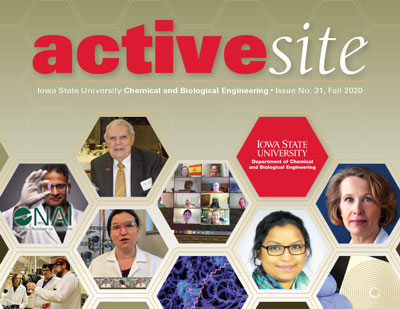As COVID-19 continues to spread, the worldwide threat demands answers. A solution to the need for simplified rapid disease testing is in the works with Iowa State’s University’s Department of Chemical and Biological Engineering (CBE).
Assistant professor and Jack R. and Carol A. Johnson Faculty Fellow Nigel Reuel and his research group are developing a no-touch, mail-in, fast-scan system for diagnosing not only COVID-19, but potentially other future disease outbreaks that could impact the world.
The work is being fast-tracked by a one-year $200,000 Rapid Response Research (RAPID) grant from the National Science Foundation (NSF). Those grants allow the NSF to provide quick process and support for research that addresses an urgent need. “Our proposed approach off-loads the burden of diagnostics from health workers, eliminates the increased use of limited personal protective equipment, and provides a better response to outbreaks,” said Reuel.
At the heart of the new approach are tightly coiled, screen-printed resonant sensors which Reuel’s current research has been applying to sensing problems in closed systems such as soil, wounds, and bioreactors. In this project, the resonant sensors are screen printed on cardstock as part of an in-home, personal COVID-19 test. To complete the test, a person would take their own nasal or cough samples, apply it to a sensor card, place the card in an envelope with a virus-killing coating, and it would be mailed to locations with readers (municipal facilities, hospitals, etc.).
There, the unopened envelope is electronically scanned to determine a positive or negative test result – and those results would then be texted or emailed back to the sender. All this convenience could possibly cost a consumer as little as $1 or less to purchase, thus enabling widespread and frequent testing.
The key to exquisite sensitivity in the new sensor system is the use of “toehold switches” that detect target RNA genetic material. That detection triggers production of “reporter” proteins that degrade portions of the resonant sensor and cause a dramatic shift in the frequency of a sensor’s signal.
During an academic conference last winter, Reuel heard more about the toehold technology from Keith Pardee, an assistant professor with the Leslie Dan Faculty of Pharmacy at the University of Toronto, who works in partnership with Alexander Green, an assistant professor with the Biodesign Center for Molecular Design and Biomimetics at Arizona State University. They had done prior work with the Zika virus and recently demonstrated a direct, electrical interface of their toehold circuit. They’re now collaborators with Reuel on this project.
Reuel said he thought the toehold technology could fit some of his ideas for a closed, contact-free diagnostic sensing system using paper-based resonant sensors. In January of 2020 he began a project to explore using this technology, aimed at general disease targets. With the subsequent outbreak of COVID-19, the focus quickly narrowed to this one critical disease, and led to seeking the RAPID grant.
Resonant sensors are simple circuits composed of inductive, capacitive, and resistive elements (LCR circuit) that tunes the resonator to oscillate current at a specific resonant frequency. The resonator can be used as a sensor by engineering the inductance, capacitance, and/or resistance elements to modulate when exposed to the desired analyte, which in turn affects the resonant frequency. They’ve been demonstrated previously measuring such things as temperature, humidity, and pressure. Reuel has been part of a research team working on a project to develop materials and methods for scalable manufacturing of flexible resonant sensors and their wireless readers. The group received a $750,000 award made available through the NSF Partnerships for Innovation (PFI) program in 2018. It included industrial partner DuPont with two co-PIs from their Advanced Electronics business. Reuel’s use of resonant sensors embedded in wound dressings also recently resulted in a prestigious 3M Untenured Faculty Award (2020). Reuel has also spun out his resonant sensors used for measuring cell viability in a startup company, Skroot Laboratory Inc. (Ames, Iowa) which is supported by NSF SBIR funds and has employed three CBE graduates.
ISU chemical engineering graduate students Adam Carr and Jared Dopp have been instrumental in developing individual components of the newly-planned COVID-19 diagnostic sensors. Plans currently call for the finished product to be a multilayered assembly on thick, color-coded paper. The top layer would hold collected nasal or cough samples, middle layers would contain the toehold switch and bottom layers a printed, coiled resonant circuit that can be scanned for telltale frequencies. “Make it very user-friendly, color-coded,” said Reuel in a television news interview about the project. “Put your sample on this color. Put it on this other one, let it sit overnight. And then just stuff it in the envelope and mail it in.”
If there’s target COVID-19 RNA in the samples, the toehold switch would allow production of proteins that degrade a coating on the circuit resulting in a positive signal. If there’s no virus RNA, there’s no protein production, no coating degradation and a negative signal.
Reuel predicts it could be at least May of 2021 before this project would be finished, approved, purchased, and employed. He says even if officials have managed to get tighter control of COVID-19 by then, the technology can still be used in the future. “Let’s say there is a mutation to the current disease, or a new pandemic surfaces,” said Reuel. “Essentially, a lot of the device platform all stays the same and you just have to swap out a few different pieces and then you’re ready for the next test.”
